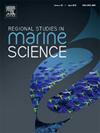Stochastic demographic analysis of the pelagic thresher shark (Alopias pelagicus) in the Ecuadorian Pacific
IF 2.4
4区 环境科学与生态学
Q3 ECOLOGY
引用次数: 0
Abstract
The pelagic thresher shark (Alopias pelagicus) is one of the most frequently landed species in Ecuador. However, its population has not been thoroughly assessed due to the lack of historical catch and fishing effort data, which precludes the use of classical stock assessment models. Consequently, this study aimed to evaluate the status of A. pelagicus in Ecuador using models designed for data-poor situations, which rely solely on life history parameters. Specifically, an age-structured model based on Leslie's matrix was used. Due to the uncertainty surrounding life history parameters, stochasticity was incorporated using various types of statistical distributions through Monte Carlo simulations. The results indicate that, in the absence of fishing, the population grows at approximately 8 % per year. However, under current fishing levels, the population is declining at a rate of about 5 % annually. Additionally, there is an 85.71 % excess in current fishing levels required to maintain a stable population. These results probably suggest that this stock is overexploited in the Ecuadorian Pacific. Different management scenarios suggest that juveniles are the most sensitive to fishing mortality. Therefore, urgent, and strict management measures are required in Ecuador to protect juveniles, such as implementing a minimum capture size above the L50 (151.4 cm of precaudal length) and protecting pregnant females.
厄瓜多尔太平洋中上层长尾鲨(Alopias pelagicus)的随机种群分析
远洋长尾鲨(Alopias pelagicus)是厄瓜多尔最常见的登陆物种之一。然而,由于缺乏历史捕捞量和捕捞努力量数据,其种群数量尚未得到彻底评估,这妨碍了经典种群评估模型的使用。因此,本研究旨在利用仅依赖生活史参数的数据贫乏情况下设计的模型来评估厄瓜多尔pelagicus的状况。具体而言,采用了基于Leslie矩阵的年龄结构模型。由于生命史参数的不确定性,通过蒙特卡罗模拟,采用各种类型的统计分布纳入随机性。结果表明,在没有捕鱼的情况下,其人口每年增长约8. %。然而,在目前的捕捞水平下,其数量正以每年5% %的速度下降。此外,维持种群稳定所需的当前捕捞水平超出了85.71% %。这些结果可能表明,这种鱼类在厄瓜多尔太平洋被过度捕捞。不同的管理方案表明,幼鱼对捕捞死亡率最敏感。因此,厄瓜多尔需要采取紧急和严格的管理措施来保护幼鱼,例如实施L50以上的最小捕获尺寸(脚掌前长度151.4 cm)和保护怀孕的雌性。
本文章由计算机程序翻译,如有差异,请以英文原文为准。
求助全文
约1分钟内获得全文
求助全文
来源期刊

Regional Studies in Marine Science
Agricultural and Biological Sciences-Ecology, Evolution, Behavior and Systematics
CiteScore
3.90
自引率
4.80%
发文量
336
审稿时长
69 days
期刊介绍:
REGIONAL STUDIES IN MARINE SCIENCE will publish scientifically sound papers on regional aspects of maritime and marine resources in estuaries, coastal zones, continental shelf, the seas and oceans.
 求助内容:
求助内容: 应助结果提醒方式:
应助结果提醒方式:


